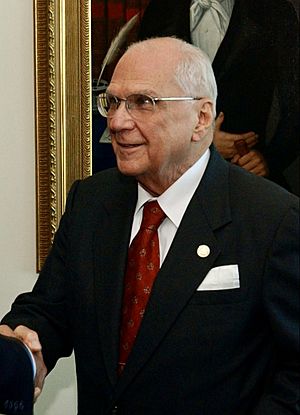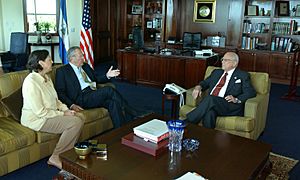Enrique Bolaños facts for kids
Quick facts for kids
Enrique Bolaños
|
|
|---|---|

Bolaños in 2004
|
|
| President of Nicaragua | |
| In office 10 January 2002 – 10 January 2007 |
|
| Vice President | José Rizo Castellón (2002–2005) Alfredo Gómez Urcuyo (2005–2007) |
| Preceded by | Arnoldo Alemán |
| Succeeded by | Daniel Ortega |
| Vice President of Nicaragua | |
| In office 10 January 1997 – 24 October 2000 |
|
| President | Arnoldo Alemán |
| Preceded by | Julia Mena |
| Succeeded by | Leopoldo Navarro Bermúdez |
| Personal details | |
| Born |
Enrique José Bolaños Geyer
13 May 1928 Nindirí, Masaya Department, Nicaragua |
| Died | 14 June 2021 (aged 93) Nindirí, Masaya Department, Nicaragua |
| Resting place | Monimbo's cemetery |
| Political party | Alliance for the Republic |
| Other political affiliations |
Constitutionalist Liberal Party |
| Spouse |
Lila Abaunza
(m. 1949; died 2008) |
| Children | 5 |
| Alma mater | Saint Louis University |
Enrique José Bolaños Geyer (born May 13, 1928 – died June 14, 2021) was a politician from Nicaragua. He served as the President of Nicaragua from January 10, 2002, to January 10, 2007. Before becoming president, Bolaños was the Vice President of Nicaragua from 1997 to 2002 under President Arnoldo Alemán.
In the 2001 presidential election, he won against Daniel Ortega. Bolaños was a member of the Constitutionalist Liberal Party (PLC). Later, he helped create a new group called the Alliance for the Republic (APRE). When he became president, he started a big campaign against corruption. This led to his predecessor, Arnoldo Alemán, being sent to prison.
Contents
Early Life and Business Career
Enrique Bolaños was born in Masaya, Nicaragua, on May 13, 1928. He went to school in Nicaragua at the Jesuit Colegio Centro América. He then studied in the United States at Saint Louis University, where he earned a degree in industrial engineering. In 1949, he married Lila Teresita Abaunza. They had five children together. One of his sons, Enrique Bolaños Abaunza, later became the head of a business school.
In 1952, Bolaños and his brothers started a business that grew cotton. By the 1970s, their company, SAIMSA, became one of the largest cotton producers in Central America. Bolaños was also an active member of a powerful business group called COSEP. He was its president from 1983 to 1988. Under his leadership, COSEP strongly opposed the Sandinista government. Bolaños believed that investing in businesses was the best way to help Nicaragua become richer.
During the 1980s, Bolaños openly disagreed with Daniel Ortega's Sandinista government. He was arrested twice in 1981 for his political activities. In 1985, the government took control of his business, SAIMSA. Bolaños felt this was because of his political views. After losing his business, he worked as a computer programmer.
In 1995, Bolaños became the campaign manager for the Constitutionalist Liberal Party (PLC). The next year, he was chosen to be the vice-presidential candidate. He ran alongside Arnoldo Alemán, who was a former mayor of Managua. They won the election, and Bolaños became Vice President on January 10, 1997.
Presidency (2002–2007)
Enrique Bolaños was chosen as the presidential candidate for the 2001 elections. Nicaragua was still recovering from Hurricane Mitch, which had caused a lot of damage in 1998. Bolaños campaigned with the slogan "let’s roll up our sleeves." He won the election with 56.3% of the votes.
Bolaños became President of Nicaragua on January 10, 2002. He served for five years. Just two days after taking office, he started a major campaign against corruption. This campaign aimed to investigate and punish government officials who had misused public money. In August, his predecessor, Arnoldo Alemán, was found guilty of fraud and misusing nearly $100 million. This case was one of the biggest in Nicaragua's history.
During his time as president, Bolaños faced many challenges. Other political groups tried to reduce his power. For example, in 2005, some groups in the National Assembly tried to change the constitution. These changes would have taken away some of the president's powers. Bolaños called this a "slow motion coup." However, with support from international groups like the OAS and the EU, these changes were delayed.
Despite these difficulties, Bolaños achieved important goals. He helped Nicaragua join the Central American Free Trade Agreement (CAFTA). He also managed to get 80% of Nicaragua’s debts forgiven by other countries. Bolaños focused on improving the country's overall economy. This led to strong economic growth, which Nicaragua had not seen in many years.

In the 2006 presidential election, Bolaños could not run for re-election because of the constitution. His party joined another group, but their candidate came in second place. On January 10, 2007, Bolaños handed over the presidency to Daniel Ortega, who had been his political opponent for a long time. As a former president, Bolaños was allowed to have a seat in the National Assembly. However, he chose to leave politics and resigned his seat in February 2007.
After the Presidency
After leaving politics, Bolaños focused on the Enrique Bolaños Foundation. This foundation is a non-profit organization that provides free access to many important documents. It includes all documents from Bolaños' presidency. It also has many digitized collections of Nicaraguan historical, political, and legal papers. This makes it a key place for historical information in the country. It is Nicaragua's first presidential library and one of the first virtual presidential libraries in Latin America. Bolaños himself helped create and develop this digital library.
Even after retiring, he continued to speak out against Daniel Ortega. Bolaños believed that Ortega had never truly left power since he first came to power in 1979.
In 2017, Bolaños published a book called The Struggle for Power. This book shared the political history of Nicaragua from 1821 to 2007. It also included his own memories from his time as president.
His wife, Lila T. Abaunza, passed away in 2008. Three of Bolaños’s children also died before him. In August 2020, his family announced that he was not in good health. Enrique Bolaños died on June 14, 2021, at his home near Managua. He was 93 years old. He was buried in the family crypt at Monimbó cemetery.
Images for kids
See also
 In Spanish: Enrique Bolaños Geyer para niños
In Spanish: Enrique Bolaños Geyer para niños



